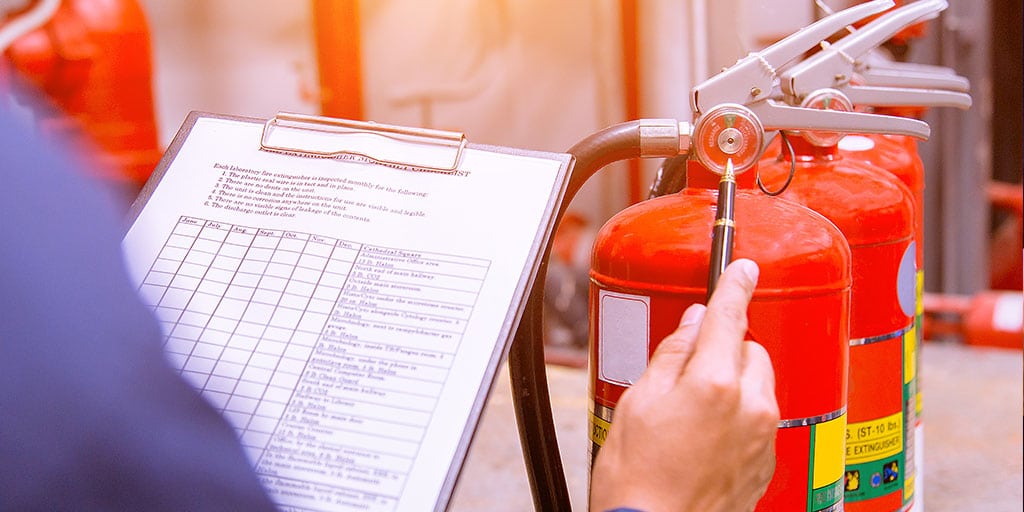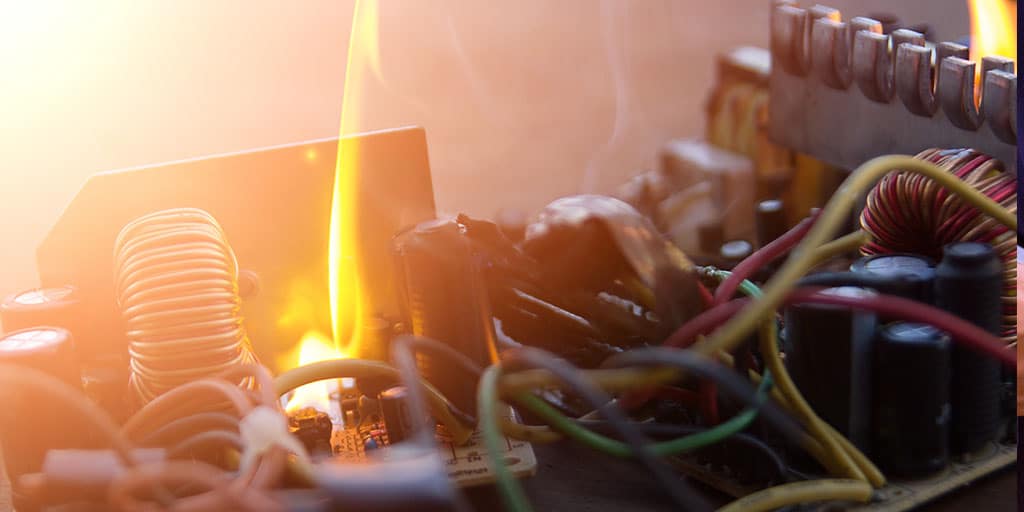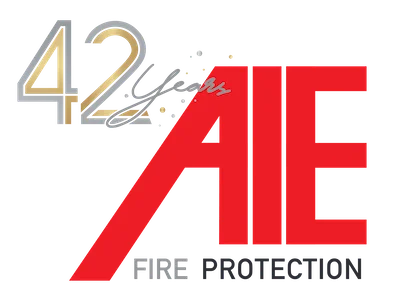AIE wants to make it as convenient as possible for you to lower the chance of fire in your retail store by providing retail safety tips and fire prevention strategies you can easily implement to minimize fire risk. Therefore, we have compiled the top 5 tips for fire safety in retail stores.
This useful advice from fire protection experts can be used to create a retail fire safety checklist to make sure you stay on track today and remain fire safety compliant in the future. Include these safety measures in retail stores:
How to Practice Fire Safety in Retail Stores: Potential Fire Hazards
No matter what type of retail store you own or manage or what you sell, it’s important to realize there can be fire hazards everywhere. You must be aware of potential fire hazards, but also how to protect against them to ensure customer safety in your business. Because of this, it is as essential to train employees on proper fire prevention methods and fire protection equipment use as it is to have the right fire protection systems in place.
What are the common fire hazards in retail stores?
- Electrical wiring/outlets
- Lighting
- Gas lines
- HVAC/furnace systems and motors
- Kitchen/breakroom cooking appliances
- Potentially flammable products like chemicals, clothing, paper
- Vandals
- Lightening
These should all be addressed in your workplace’s fire protection plan.
Create a Fire Protection Plan: What to Include
So, how do you implement fire prevention strategies that improve the chances of keeping your customers, employees, and business safe? Start by creating a fire protection plan using the steps below and follow safety guidelines for retail stores from your local Authorities Having Jurisdiction (AHJ) and NFPA regulations.
According to the 2009-2108 FEMA Fire Estimate Summary, in 2018, 103,600 commercial buildings experienced fires, 10,000 of which were set intentionally, resulting in $2.7 billion in total losses.
#1 – Fire Prevention as Daily Retail Fire Safety Checklist
The best thing you can do to practice fire safety in retail stores is to make fire prevention part of your daily routine. Implement a retail store safety checklist that must be initialed by employees assigned to clean throughout the day and ensure everything is off and/or unplugged at closing time.
The business fire protection checklist is the first piece of your overall fire prevention and protection plan. In addition to a general retail checklist, you may also want to create a retail store inspection checklist to ensure you’re prepared for surprise and routine inspections.
Things to Include in Your Business’s Daily Fire Safety Checklist:
Make inspections, repair, and maintenance of electrical wires, gas lines, plumbing, utility connections, and all fire-protection equipment part of your regular routine to ensure they don’t become a fire hazard and that they work when needed. These should all be included in your retail fire safety plan.
Keep flammable items such as paper, clothing, and chemicals away from electrical outlets, flames, and static electricity. If you have a kitchen or breakroom with a hot plate, toaster, or cooking surface, keep it grease-free and clear of clutter. The most common cause of commercial fires is cooking (over 30,000 year), so be sure to consider this when creating your checklist for fire safety.
Stop trash from overflowing and put it in the dumpster as needed rather than just near the door. This opens doorways and evacuation paths in case of emergency and keeps flammables away from running electrical and gas appliances, the furnace or air conditioner, overheated motors, machinery, or even smoldering cigarette butts. Maintaining clean, uncluttered work areas keeps the fire load to a minimum.
#2 – Inspect Fire Extinguishers Monthly & Know Where They Are
Here are the basic fire extinguisher rules and recommendations:
It can be challenging to remember how to use an extinguisher when under stress, so it is helpful to memorize the acronym PAST – Pull the pin, Aim at the base, Sweep and Spray from Ten feet away.

#3 – Proper Training on Retail Fire Safety for Employees
Make sure your staff receives proper fire safety training so they can easily follow your business fire safety checklist. Only with proper employee training and adherence to NFPA and OSHA standards can you provide the safest retail stores. Protect your customers and staff with routine, quality training.
Teach all employees fire-safety protocol, evacuation procedures, and the use of fire safety equipment right away. Ensure they know where all fire extinguishers and fire exits are located and how to calmly get customers and each other out of the building. Hold a mandatory annual fire safety refresher course for all staff.
It is also recommended to designate certain employees per shift to shut off gas and electrical power in case of emergency. Assign others to be emergency “evacuation managers” who call 911 and get everyone out of the store should there be a fire alarm or threat.
#4 – Inspect & Maintain Your Fire Sprinkler & Support
Unfortunately, not every retail business is required by law to have a fire sprinkler or suppression system, but if you do, they may be of no use to anyone unless you inspect and maintain them. Routine fire sprinkler inspections and maintenance can reduce fire damage and ensure your locations are as safe as possible.
Depending on the type of system you have and your hazard classification, quarterly and annual inspections are mandated by NFPA code and must be performed by a state-licensed technician. If you need repairs or maintenance, it is best to use an experienced, certified technician with a satisfaction guarantee. AIE offers all fire protection and life-safety inspections, maintenance, and repair services nationwide, satisfaction-guaranteed.
Did you know, a licensed sprinkler inspector can legally inspect your backflow preventors, but a backflow inspector cannot, by code, inspect your sprinkler system? Save time and money by using a licensed fire sprinkler inspector to do both
#5 – Add Fire Alarm Monitoring to Fire Protection Plan
Fire alarm monitoring is an integral part of retail fire safety. It can reduce response time when a fire occurs in a retail business. If a fire alarm goes off in your store, a fire alarm monitoring device assesses the signal to rule out a false alarm (which can save panic and upheaval) and instantly transmits a real fire emergency to first responders. The fire department can be on its way often before a person can call 911 or physically get help, especially when trapped by fire.
Fire alarm monitoring is also useful if there is a fire when your store is closed and nobody is there. This is more common than most people realize. Arsonists were responsible for setting 10,200 non-residential fires in 2018, a 15% increase over ten years. Fire alarm monitoring cuts down on fire fighter notification time and speeds up their arrival, saving merchandise, property, and most importantly – lives.

Maximize Retail Fire Safety & Minimize Fire Risk
Fire risk is higher than most retail store owners and managers realize. Utilizing our fire prevention strategies to create a safety plan and daily checklist is imperative to the safety of your business. By sharing these 5 fire safety tips, AIE hopes you see just how easy and cost-effective, yet critical, fire prevention and safety strategies are to minimize fire danger, keep your customers and staff safe, and add to the longevity of your business.
There are many common fire hazards in the workplace, so you must be prepared. Get started on your retail store fire safety checklist now!
Retail Fire Protection Specialists: Here for You
Looking for retail fire protection specialists? We understand the hazards in retail stores. If you have questions about creating a fire prevention and protection plan or would like to partner with one nationwide fire safety source that specializes in mid-size to big-box retail facilities, contact AIE’s fire experts today, 800-892-9863.
We’ve worked with retail stores of many sizes to develop workplace fire safety checklists and ensure their locations follow all retail store safety regulations.
Information posted in our blog is merely for educational and informational purposes. While the information has been verified to the best of our abilities, we cannot guarantee its total accuracy, and it should not be considered legally binding advice. This blog is not intended as a substitute for professional advice, and should you decide to act upon the information, you do so at your own risk.


Recent Comments